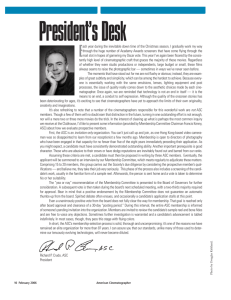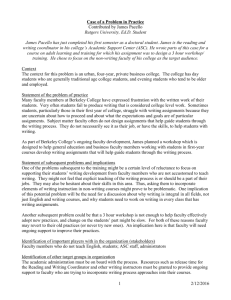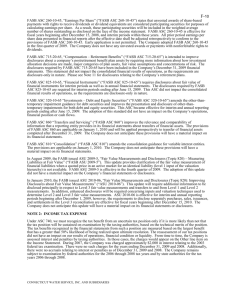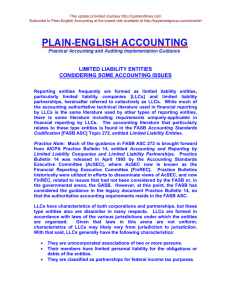AccountingAlert - Grant Thornton
advertisement
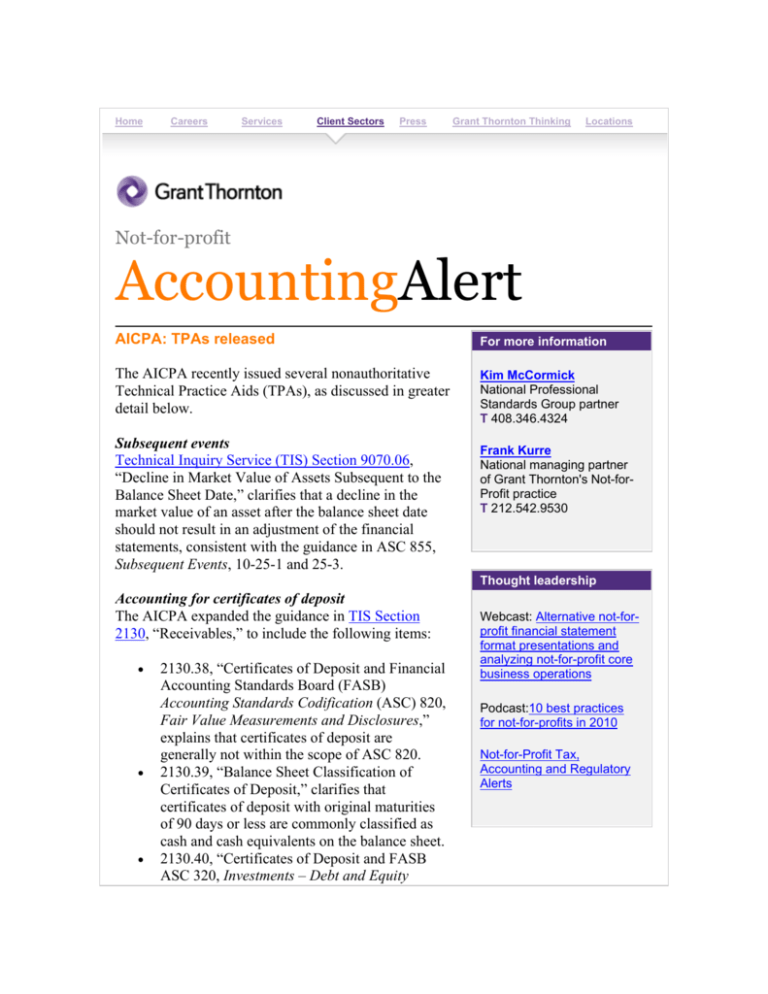
Home Careers Services Client Sectors Press Grant Thornton Thinking Locations Not-for-profit AccountingAlert AICPA: TPAs released For more information The AICPA recently issued several nonauthoritative Technical Practice Aids (TPAs), as discussed in greater detail below. Kim McCormick National Professional Standards Group partner T 408.346.4324 Subsequent events Technical Inquiry Service (TIS) Section 9070.06, “Decline in Market Value of Assets Subsequent to the Balance Sheet Date,” clarifies that a decline in the market value of an asset after the balance sheet date should not result in an adjustment of the financial statements, consistent with the guidance in ASC 855, Subsequent Events, 10-25-1 and 25-3. Frank Kurre National managing partner of Grant Thornton's Not-forProfit practice T 212.542.9530 Thought leadership Accounting for certificates of deposit The AICPA expanded the guidance in TIS Section 2130, “Receivables,” to include the following items: • • • 2130.38, “Certificates of Deposit and Financial Accounting Standards Board (FASB) Accounting Standards Codification (ASC) 820, Fair Value Measurements and Disclosures,” explains that certificates of deposit are generally not within the scope of ASC 820. 2130.39, “Balance Sheet Classification of Certificates of Deposit,” clarifies that certificates of deposit with original maturities of 90 days or less are commonly classified as cash and cash equivalents on the balance sheet. 2130.40, “Certificates of Deposit and FASB ASC 320, Investments – Debt and Equity Webcast: Alternative not-forprofit financial statement format presentations and analyzing not-for-profit core business operations Podcast:10 best practices for not-for-profits in 2010 Not-for-Profit Tax, Accounting and Regulatory Alerts Securities,” explains that certificates of deposit are generally not within the scope of ASC 320. Fair value disclosures TIS Section 1800.05, “Applicability of Fair Value Disclosure Requirements and Measurement Principles in Financial Accounting Standards Board (FASB) Accounting Standards Codification (ASC) 820, Fair Value Measurements and Disclosures, to Certain Financial Instruments,” clarifies that the measurement principles in ASC 820 apply to financial instruments that are not recognized at fair value in the statement of financial position, but that must be disclosed at fair value in the notes to the financial statements. Not-for-profit entities The AICPA expanded the guidance in TIS Section 6140, “Not-for-Profit Entities,” to include the following items: • • • 6140.23, “Changing Net Asset Classifications Reported in a Prior Year,” explains that individual net asset classes, rather than net assets in the aggregate, are relevant in determining whether a not-for-profit entity’s correction of net asset classifications previously reported in prior years’ financial statements is considered an error in previously issued financial statements. 6140.24, “Contributions of Certain Nonfinancial Assets, Such as Fundraising Material, Informational Material, or Advertising, Including Media Time or Space for Public Service Announcements or Other Purposes,” explains how not-for-profit entities should consider whether certain nonfinancial assets used for the entity’s benefit, such as fundraising material, informational material, or advertising including media time or space for public service announcements or other purposes, constitute a contribution. 6140.25, “Multiyear Unconditional Promises to Give – Measurement Objective and the Effect of Changes in Interest Rates,” clarifies that the measurement objective for multiyear unconditional promises to give, including both revenue and contributions receivable, is fair value, except for subsequent measurement of contributions receivable for which the entity has not elected the fair value option. Cash value life insurance policies TIS Section 2240.06, “Measurement of Cash Value Life Insurance Policy,” cites guidance from ASC 325, Investments – Other, 30, “Investments in Insurance Contracts,” 25-1, 35-1, and 35-3 through 35-7, to explain the appropriate measurement and recognition of a cash value life insurance policy that a company purchases for itself. TIS Section 6930.02, “Defined Benefit Plan Measurement of a Life Insurance Policy,” clarifies that for some insurance contracts with insurance entities, the best available evidence of fair value may be contract value. Further, if the contract has a determinable cash surrender value or conversion value, that is presumed to represent the contract’s fair value. Applying FIN 48 The AICPA expanded the guidance in TIS Section 5250, “Tax Allocation,” to include the following items: • • 5250.14, “Application of Financial Accounting Standards Board (FASB) Interpretation No. 48, Accounting for Uncertainty in Income Taxes (codified in FASB Accounting Standards Codification [ASC] 740-10) to Taxes Other Than Income Taxes,” clarifies that the scope of FASB Interpretation 48, Accounting for Uncertainty in Income Taxes, as codified in ASC 740-10, Income Taxes, includes income taxes only. 5250.15, “Application of Certain FASB Interpretation No. 48 (codified in FASB ASC 740-10) Disclosure Requirements to Nonpublic Entities That Do Not Have Uncertain Tax Positions,” clarifies that the guidance in ASC 740-10-50-15(e), which requires a description of tax years that remain subject to examination, applies to nonpublic entities, even if they have no uncertain tax positions. Questions? For additional information, contact Kim McCormick, national Professional Standards Group partner, at 408.346.4324, Frank Kurre, national managing partner of Grant Thornton's Not-for-Profit practice, at 212.542.9530, or your local client-service partner. This Grant Thornton LLP bulletin provides information and comments on current accounting and tax issues and developments. It is not a comprehensive analysis of the subject matter covered and is not intended to provide accounting, tax, or other advice or guidance with respect to the matters addressed in the document. All relevant facts and circumstances, including the pertinent authoritative literature, need to be considered to arrive at conclusions that comply with matters addressed in this bulletin.




